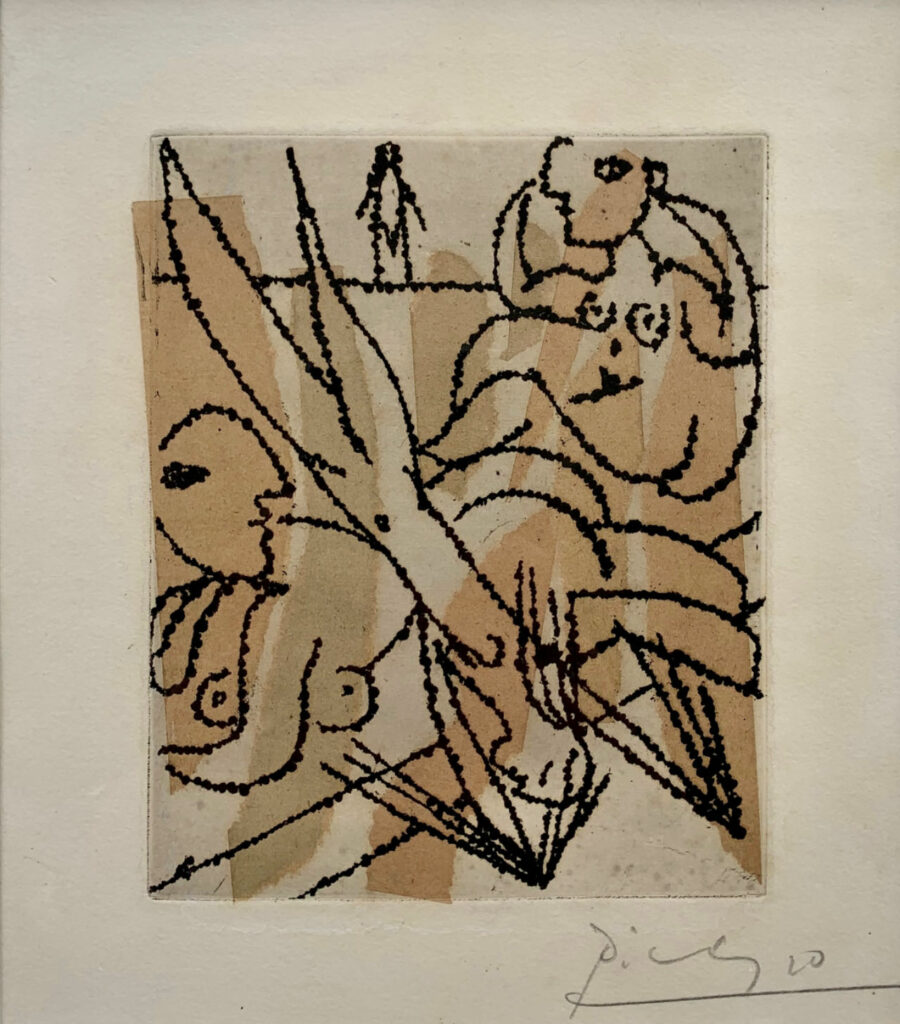
La Plongeuse, “The Diver,” is a lovely little scene swathed in colour with the same depth and texture as a crowded public beach or pool on a sunny day. The dense composition shows two voluptuous nude women lounging at the edge of a body of water precisely at the moment when another nude woman dives over them and into the pool. Picasso created the unique pebbled lines of the figures by leaving large bubbles in the acid he used to etch the plates.
The diver’s lithe, tapered frame offers a contrast to the other women in the image, whose Rubenesque curves nod to Picasso’s classical sensibilities of this time. Sharp linear splashes cut through their relaxation and, with one covering her ears and the other turning her head in apparent judgment, we can interpret the dive as disturbing the otherwise peaceful mood. In the background, at the horizon, is another figure: a nude man perhaps, judging by the triangular addition to his lower body.
Bathers were a point of fascination for Picasso, especially in the 1920s and 30s. In this era, the French Riviera became the vacation destination, a lush and sensual place where the artist spent his summers, among other fabulous sun worshippers (including F. Scott Fitzgerald whose novel Tender Is the Night is set on the same shores).* The Riviera was an epicentre of the hedonistic freedoms the 1920s had to offer, evoking a kind of mythic joy Picasso equated to Dionysus and his merry band of revellers. However, influenced by less-than-idyllic external factors like a separation with Olga and the impending threat of fascism in Europe, his summers morphed. Some depictions are more celebratory than others, always returning to sexuality.
During the winter of 1932, Picasso created La Plongeuse along with numbers of more etchings showing women at the beach. The previous summer, he painted similar scenes on a larger scale. Though much smaller, his etchings give the viewer a greater sense of intimacy with each pairing of subjects, mirroring the experience of focusing on a particular person or group while people-watching. This voyeuristic overtone is emphasised by the man lurking on the horizon line as the diver makes her splash.
In comparing Picasso’s frequent portrayals of bathers, there are both overarching similarities to Greco-Roman mythology (e.g. unapologetic nudity, lounging, frolicking) and hints to specific stories from the ancient world. The first of these is the myth of Diana and Actaeon from Ovid’s Metamorphoses (another Picasso favorite). In the story, the mortal hunter stumbles upon the goddess while she is being bathed by her nymphs. Horrified at his intrusion, these attendants rush to cover Diana, who turns the man into a deer as an ironic punishment.** This story was popular in the Renaissance and adapted by great masters like Rembrandt and Titian, two painter-printmaker geniuses who Picasso deeply admired. The other major reference here is the biblical tale of Susanna and the Elders, in which a young bathing woman is assaulted by two male elders. In its Baroque adaptions of the 18th century, Susanna acted as a symbol of virtue and modesty.*** Diana’s popularity throughout art history can also be interpreted as such, with male voyeurism causing both female figures great shame and anguish.
However, this sense of embarrassment appears to be entirely absent in La Plongeuse. Could this be the moment before the women realise they are being watched? Or, thinking back to the inspiration for this print series as an expression of new sexual freedoms, it’s possible there was no longer a feeling of being “caught.” In this way, La Plongeuse is an entirely modern renewal of these ancient tales, depicting a world where such blatant sexuality could be celebrated or at least not punishable. If anyone carries an aura of shame, it might be the man watching them. He is not acknowledged at all by the bathers and this seems to be a worse fate than being perceived. Does Picasso imagine himself as this man, hoping to be seen rather than be a looming figure in the background?
Courtesy of John Szoke Gallery, New York.
